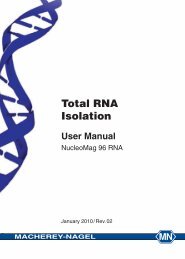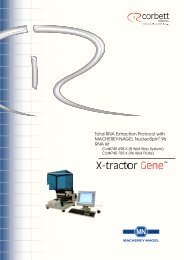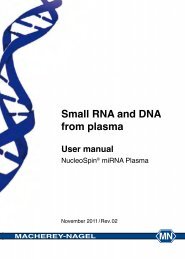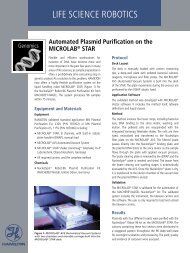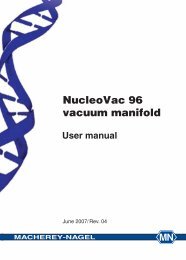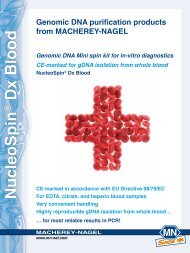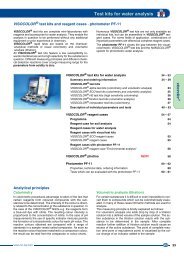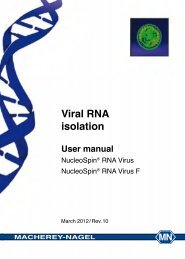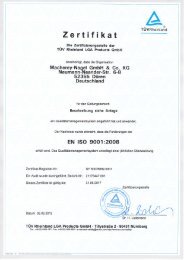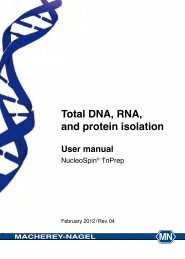NucleoBond® Finalizer - Macherey Nagel
NucleoBond® Finalizer - Macherey Nagel
NucleoBond® Finalizer - Macherey Nagel
Create successful ePaper yourself
Turn your PDF publications into a flip-book with our unique Google optimized e-Paper software.
Plasmid DNA<br />
concentration<br />
and desalting<br />
User manual<br />
MACHEREY-NAGEL<br />
NucleoBond ® <strong>Finalizer</strong><br />
NucleoBond ® <strong>Finalizer</strong> Large<br />
October 2011 / Rev. 06
Plasmid DNA concentration and desalting<br />
Protocol-at-a-glance (Rev. 06)<br />
NucleoBond ®<br />
<strong>Finalizer</strong><br />
1 Precipitate DNA 3.5 mL isopropanol for<br />
5 mL eluate<br />
2 Load precipitate<br />
3 Wash precipitate<br />
4 Dry filter membrane<br />
Mix thoroughly<br />
(Watch salt concentration)<br />
RT, 2 min<br />
2 mL<br />
70 % ethanol<br />
≥ 3 x air<br />
5 Elute DNA Two-fold elution:<br />
1st elution<br />
200–800 μL<br />
Tris or TE buffer<br />
2nd elution<br />
Load first eluate<br />
completely<br />
Press slowly!<br />
Press fast!<br />
Press very<br />
slowly!<br />
Recover as much eluate as possible by<br />
quickly pressing air through the filter.<br />
MACHEREY-NAGEL GmbH & Co. KG · Neumann-Neander-Str. 6–8 · 52355 Düren · Germany<br />
Tel.: +49 24 21 969-270 · Fax: +49 24 21 969-199 · tech-bio@mn-net.com · www.mn-net.com<br />
NucleoBond ®<br />
<strong>Finalizer</strong> Large<br />
10.5 mL isopropanol for<br />
15 mL eluate<br />
Mix thoroughly<br />
(Watch salt concentration)<br />
RT, 2 min<br />
5 mL<br />
70 % ethanol<br />
≥ 6 x air<br />
Two-fold elution:<br />
1st elution<br />
400–1000 μL<br />
Tris or TE buffer<br />
2nd elution<br />
Load first eluate<br />
completely
Table of contents<br />
Plasmid DNA concentration and desalting<br />
1 Components 4<br />
1.1 Kit contents 4<br />
1.2 Reagents to be supplied by the user 5<br />
1.3 About this user manual 5<br />
2 Product description 6<br />
2.1 The basic principle 6<br />
2.2 Kit specifications 6<br />
2.3 DNA precipitation 8<br />
2.4 Elution procedure 8<br />
3 Storage conditions 11<br />
4 Safety instructions – risk and safety phrases 11<br />
5 Protocol for DNA concentration and desalination 12<br />
6 Appendix 15<br />
6.1 Determination of DNA yield and quality 15<br />
6.2 Troubleshooting 15<br />
6.3 Ordering information 18<br />
6.4 Product use restriction / warranty 19<br />
MACHEREY-NAGEL – 10 / 2011, Rev. 06<br />
3
1 Components<br />
1.1 Kit contents<br />
4<br />
Plasmid DNA concentration and desalting<br />
NucleoBond ®<br />
<strong>Finalizer</strong><br />
MACHEREY-NAGEL – 10 / 2011, Rev. 06<br />
NucleoBond ®<br />
<strong>Finalizer</strong> Plus<br />
REF 740519.20 740520.20<br />
NucleoBond ® <strong>Finalizer</strong> 20 20<br />
30 mL Syringes 2 20<br />
1 mL Syringes 2 20<br />
User manual 1 1<br />
NucleoBond ®<br />
<strong>Finalizer</strong> Large<br />
NucleoBond ®<br />
<strong>Finalizer</strong> Large Plus<br />
REF 740418.20 740419.20<br />
NucleoBond ® <strong>Finalizer</strong> Large 20 20<br />
30 mL Syringes 2 20<br />
1 mL Syringes 2 20<br />
User manual 1 1
Plasmid DNA concentration and desalting<br />
1.2 Reagents to be supplied by the user<br />
• Isopropanol (room-temperatured)<br />
• 70 % ethanol (room-temperatured)<br />
• Buffer for reconstitution of DNA (e.g., Tris or TE buffer; see section 2.4)<br />
1.3 About this user manual<br />
It is strongly recommended that first-time users of the NucleoBond ® <strong>Finalizer</strong> (Large)<br />
read the detailed protocol sections of this user manual. Experienced users, however,<br />
may refer to the Protocol-at-a-glance instead. The Protocol-at-a-glance is designed<br />
to be used only as a supplemental tool for quick referencing while performing the<br />
purification procedure.<br />
All technical literature is available on the internet at www.mn-net.com.<br />
MACHEREY-NAGEL – 10 / 2011, Rev. 06<br />
5
2 Product description<br />
2.1 The basic principle<br />
6<br />
Plasmid DNA concentration and desalting<br />
NucleoBond ® <strong>Finalizer</strong>s are designed for quick concentration and desalination of<br />
plasmid and cosmid DNA eluates that are obtained by anion-exchange chromatographic<br />
DNA purification with NucleoBond ® AX and NucleoBond ® Xtra Columns. The sample<br />
is precipitated with isopropanol and loaded onto a NucleoBond ® <strong>Finalizer</strong> membrane<br />
by means of a syringe. After an ethanolic washing step and drying of the membrane the<br />
pure DNA can be eluted with low salt buffer for further use. The NucleoBond ® <strong>Finalizer</strong><br />
technology replaces the tedious and time-consuming centrifugation step which hitherto<br />
follows every isopropanol precipitation of diluted DNA samples. Furthermore problems<br />
like lost DNA pellets or incomplete solubilization of hardly visible precipitates can easily<br />
be circumvented. The pure concentrated and salt free DNA can be used directly for all<br />
common downstream applications like transfection, in vitro transcription, automated or<br />
manual sequencing, cloning, hybridization, and PCR.<br />
2.2 Kit specifications<br />
• The NucleoBond ® <strong>Finalizer</strong> kits contain the NucleoBond ® <strong>Finalizer</strong>s and a<br />
set of 30 mL and 1 mL syringes for sample loading and DNA elution.<br />
• The protocol is suitable for purifying most plasmids and cosmids ranging from<br />
2– 50 kbp.<br />
• NucleoBond ® <strong>Finalizer</strong>s are polypropylene filters containing a special silica<br />
membrane. The NucleoBond ® <strong>Finalizer</strong> with a binding capacity of 500 μg<br />
is suitable for use with NucleoBond ® PC 100, PC 500, and NucleoBond ®<br />
Xtra Midi kits. The NucleoBond ® <strong>Finalizer</strong> Large can hold up to 2000 μg<br />
and is suitable for use with NucleoBond ® Xtra Maxi and NucleoBond ® PC<br />
2000 kits. Both NucleoBond ® <strong>Finalizer</strong>s are also suitable for all other plasmid<br />
DNA purification or concentration procedures resulting in an isopropanol DNA<br />
precipitate.<br />
• The NucleoBond ® <strong>Finalizer</strong>s are free of endotoxins and can therefore be used<br />
with NucleoBond ® PC EF kits and NucleoBond ® Xtra EF kits as well.<br />
• All NucleoBond ® <strong>Finalizer</strong>s are resistant to organic solvents such as alcohol,<br />
chloroform, and phenol and are free of DNase and RNase.<br />
• Using the NucleoBond ® <strong>Finalizer</strong> kits reduces the necessary hands-on time to<br />
obtain concentrated DNA from over an hour to about 5 minutes.<br />
• Due to the small filter size an effective washing step reduces chloride<br />
concentration in the final eluate to < 0.3 μg/μL.<br />
• The supplied syringes may be reused when washed with sufficient water.<br />
MACHEREY-NAGEL – 10 / 2011, Rev. 06
Table 1: Kit specifications at a glance<br />
Plasmid DNA concentration and desalting<br />
Parameter NucleoBond ®<br />
<strong>Finalizer</strong><br />
Loadable volume Unlimited<br />
MACHEREY-NAGEL – 10 / 2011, Rev. 06<br />
NucleoBond ®<br />
<strong>Finalizer</strong> Large<br />
Binding capacity 500 μg DNA 2000 μg DNA<br />
Elution volume > 200 μL > 400 μL<br />
Typical recovery<br />
(elution volume dependent)<br />
Typical concentration<br />
(elution volume dependent)<br />
40–90 %<br />
0.1–3 μg/μL<br />
Plasmid size 2–50 kbp<br />
Residual chloride<br />
concentration<br />
< 0.3 μg/μL<br />
Dead volume ~ 30 μL ~ 60 μL<br />
Preparation time 5 min<br />
To be combined with NucleoBond ® Xtra Midi<br />
NucleoBond ® Xtra Midi EF<br />
NucleoBond ® PC 100<br />
NucleoBond ® PC 500<br />
NucleoBond ® PC 500 EF<br />
NucleoBond ® Xtra Maxi<br />
NucleoBond ® Xtra Maxi EF<br />
NucleoBond ® PC 2000<br />
NucleoBond ® PC 2000 EF<br />
7
2.3 DNA precipitation<br />
8<br />
Plasmid DNA concentration and desalting<br />
In general diluted DNA can be precipitated by adding 0.7 volumes of isopropanol to<br />
solutions containing at least 0.3 M sodium acetate, 0.2 M sodium chloride, or 0.2 M<br />
potassium chloride. Make sure your samples contain enough salt before using the<br />
NucleoBond ® <strong>Finalizer</strong> kits.<br />
NucleoBond ® PC 100, PC 500, PC 2000, Xtra Midi, and Xtra Maxi eluates as well as<br />
similar anion-exchange chromatography eluates already contain a sufficient amount<br />
of salt to allow a quantitative DNA precipitation. Here, only addition of 0.7 volumes of<br />
room temperature (20–25 °C) isopropanol (not provided in the kit) is necessary. Do<br />
not let the plasmid DNA solution drop into a vial with isopropanol, because this might<br />
lead to spontaneous co-precipitation of salt.<br />
2.4 Elution procedure<br />
Elution from the NucleoBond ® <strong>Finalizer</strong>s is carried out with slightly alkaline buffers<br />
like TE buffer (10 mM Tris / HCl, pH 7.5, 1 mM EDTA) or Tris buffer (5 mM Tris / HCl,<br />
pH 8.5). DNA precipitation is performed at room temperature in contrast to a standard<br />
incubation on ice or -20 °C in order to avoid co-precipitation of salt.<br />
For maximum yield it is recommended to perform the elution step twice. The first elution<br />
step is done using fresh buffer whereas in the second elution step the eluate from the<br />
first elution is reapplied on the NucleoBond ® <strong>Finalizer</strong> to allow complete solubilization<br />
of the plasmid.<br />
DNA recovery highly depends on the used elution buffer volume. Large volumes result<br />
in a high recovery of up to 90 % but in a lower DNA concentration. Small elution volumes<br />
on the other hand increase the concentration but at the cost of DNA yield.<br />
If a small volume is chosen, make sure to recover as much eluate as possible from<br />
the syringe and NucleoBond ® <strong>Finalizer</strong> by pressing air through the NucleoBond ®<br />
<strong>Finalizer</strong> several times after elution and collecting every single droplet to minimize the<br />
dead volume.<br />
Figures 1 and 2 on page 9 and 10 illustrate exemplarily how DNA recovery and final<br />
DNA concentration depend on the buffer volume which is used for elution of DNA from<br />
the NucleoBond ® <strong>Finalizer</strong> and NucleoBond ® <strong>Finalizer</strong> Large, respectively.<br />
MACHEREY-NAGEL – 10 / 2011, Rev. 06
Recovery [%]<br />
100<br />
90<br />
80<br />
70<br />
60<br />
50<br />
40<br />
30<br />
20<br />
10<br />
Plasmid DNA concentration and desalting<br />
0<br />
0 200 400 600 800 1000<br />
Elution volume [µL]<br />
2.0<br />
1.6<br />
1.4<br />
1.0<br />
0.6<br />
0.4<br />
0.0<br />
Concentration [µg/µL]<br />
MACHEREY-NAGEL – 10 / 2011, Rev. 06<br />
Recovery<br />
Concentration<br />
Concentration [µg/µl]<br />
Figure 1 Final DNA recovery and concentration after NucleoBond ® <strong>Finalizer</strong> application<br />
A NucleoBond ® Xtra Midi eluate containing 250 μg plasmid DNA (8 kbp) was loaded<br />
onto a NucleoBond ® <strong>Finalizer</strong> and eluted two-fold with increasing volumes of TE buffer.<br />
The NucleoBond ® <strong>Finalizer</strong> is designed to hold a maximum of 500 μg DNA and is<br />
therefore ideally suited to be used in combination with NucleoBond ® PC 100, PC<br />
500, and NucleoBond ® Xtra Midi. Maximum DNA recovery can be achieved by using<br />
> 600 μL of elution buffer. For a higher concentration experienced users can lower the<br />
elution buffer volume to 400–200 μL.<br />
Table 2 gives an overview about recovery and concentration of different amounts of<br />
plasmid DNA loaded onto a NucleoBond ® <strong>Finalizer</strong> and eluted two-fold with increasing<br />
volumes of TE buffer. Please refer to this table to select an elution buffer volume that<br />
meets your needs best.<br />
Table 2: DNA recovery and concentration for the NucleoBond ® <strong>Finalizer</strong><br />
Loaded DNA<br />
500 μg<br />
250 μg<br />
100 μg<br />
50 μg<br />
1.8<br />
1.2<br />
0.8<br />
0.2<br />
Elution volume<br />
100 μL 200 μL 400 μL 600 μL 800 μL 1000 μL<br />
35 % 60 % 70 % 75 % 75 % 75 %<br />
2.5 μg/μL 2.3 μg/μL 1.2 μg/μL 0.8 μg/μL 0.6 μg / μL 0.5 μg/μL<br />
40 % 65 % 75 % 80 % 80% 80 %<br />
1.9 μg/μL 1.1 μg/μL 0.6 μg/μL 0.4 μg/μL 0.3 μg / μL 0.2 μg/μL<br />
45 % 70 % 80 % 85 % 85 % 85 %<br />
0.7 μg/μL 0.4 μg/μL 0.2 μg/μL 0.1 μg/μL 0.1 μg / μL 0.1 μg/μL<br />
30 % 75 % 85 % 90 % 90 % 90 %<br />
0.3 μg/μL 0.2 μg/μL 0.1 μg/μL 0.1 μg/μL 0.1 μg / μL < 0.1 μg/μL<br />
DNA recovery<br />
DNA concentration<br />
9
10<br />
Recovery [%]<br />
100<br />
90<br />
80<br />
70<br />
60<br />
50<br />
40<br />
30<br />
20<br />
10<br />
Concentration [µg/µL]<br />
MACHEREY-NAGEL – 10 / 2011, Rev. 06<br />
Recovery<br />
Concentration<br />
Concentration [µg/µl]<br />
0<br />
0.0<br />
0 200 400 600 800 1000<br />
Elution volume [µL]<br />
Figure 2 Final DNA recovery and concentration after NucleoBond ® <strong>Finalizer</strong> Large<br />
application<br />
A NucleoBond ® Xtra Maxi eluate containing 1000 μg plasmid DNA (8 kbp) was loaded<br />
onto a NucleoBond ® <strong>Finalizer</strong> Large and eluted two-fold with increasing volumes of TE<br />
buffer.<br />
NucleoBond ® Xtra Maxi and NucleoBond ® PC 2000 eluates are easily concentrated<br />
with a NucleoBond ® <strong>Finalizer</strong> Large which is able to bind up to 2000 μg plasmid<br />
DNA. Maximum DNA recovery can be achieved by using > 800 μL of elution buffer.<br />
For a higher concentration experienced users can lower the elution buffer volume to<br />
600–400 μL.<br />
Table 3 gives an overview about recovery and concentration of different amounts of<br />
plasmid DNA loaded onto a NucleoBond ® <strong>Finalizer</strong> Large and eluted two-fold with<br />
increasing volumes of TE buffer. Please refer to this tables to select an elution buffer<br />
volume that meets your needs best.<br />
Table 3: DNA recovery and concentration for the NucleoBond ® <strong>Finalizer</strong> Large<br />
Loaded DNA<br />
1500 μg<br />
1000 μg<br />
500 μg<br />
100 μg<br />
Plasmid DNA concentration and desalting<br />
3.0<br />
2.5<br />
2.0<br />
1.5<br />
1.0<br />
0.5<br />
Elution volume<br />
100 μL 200 μL 400 μL 600 μL 800 μL 1000 μL<br />
5 % 30 % 65 % 80 % 85 % 90 %<br />
1.9 μg/μL 3.2 μg/μL 2.9 μg/μL 2.2 μg/μL 1.7 μg/μL 1.4 μg/μL<br />
5 % 35 % 70 % 85 % 90% 90 %<br />
1.3 μg/μL 2.5 μg/μL 2.1 μg/μL 1.6 μg/μL 1.2 μg/μL 1.0 μg/μL<br />
10 % 40 % 70 % 85 % 90 % 90 %<br />
1.3 μg/μL 1.4 μg/μL 1.0 μg/μL 0.8 μg/μL 0.6 μg/μL 0.5 μg/μL<br />
15 % 45 % 70 % 80 % 85 % 90 %<br />
0.4 μg/μL 0.3 μg/μL 0.2 μg/μL 0.1 μg/μL 0.1 μg/μL 0.1 μg/μL<br />
DNA recovery<br />
DNA concentration
3 Storage conditions<br />
Plasmid DNA concentration and desalting<br />
All kit components can be stored at room temperature (18–25 °C).<br />
4 Safety instructions – risk and safety phrases<br />
The components of the NucleoBond ® <strong>Finalizer</strong> and NucleoBond ® <strong>Finalizer</strong> Large kits<br />
do not contain hazardous contents.<br />
MACHEREY-NAGEL – 10 / 2011, Rev. 06<br />
11
5 Protocol for DNA concentration and<br />
desalination<br />
1 Precipitate DNA<br />
12<br />
NucleoBond ®<br />
<strong>Finalizer</strong><br />
MACHEREY-NAGEL – 10 / 2011, Rev. 06<br />
NucleoBond ®<br />
<strong>Finalizer</strong> Large<br />
Note: Check DNA concentration photometrically before precipitation. This helps to<br />
choose the best buffer volume in step 5 and allows calculation of the recovery after<br />
concentration.<br />
Using eluates from anion-exchange chromatography add 0.7 volumes of roomtemperature<br />
isopropanol (not supplied with the kit). Vortex well and let the<br />
mixture sit for 2 minutes.<br />
(E.g., for 5 mL NucleoBond ® PC 100 or Xtra Midi eluate add 3.5 mL isopropanol,<br />
for 15 mL NucleoBond ® PC 500 or Xtra Maxi eluate add 10.5 mL isopropanol.)<br />
If your sample does not contain high salt concentrations (e.g., 0.2 M sodium<br />
chloride, 0.3 M sodium acetate, or 0.2 M potassium chloride), add about 1/10<br />
volume of 3 M sodium acetate (pH 4.2) before adding isopropanol.<br />
2 Load precipitate<br />
3.5 mL for<br />
5 mL eluate<br />
10.5 mL for<br />
15 mL eluate<br />
Remove the plunger from a 30 mL Syringe and attach a NucleoBond ® <strong>Finalizer</strong><br />
to the outlet.<br />
Fill the precipitation mixture into the syringe, insert the plunger, hold the syringe<br />
in a vertical position, and press the mixture slowly through the NucleoBond ®<br />
<strong>Finalizer</strong> using minimal force. Discard the flow-through.<br />
3 Wash precipitate<br />
NucleoBond ® <strong>Finalizer</strong> / <strong>Finalizer</strong> Large<br />
Remove the NucleoBond ® <strong>Finalizer</strong> from the syringe, pull out the plunger and<br />
reattach the NucleoBond ® <strong>Finalizer</strong> to the syringe outlet.<br />
Fill 70 % ethanol (not supplied with the kit) into the syringe, insert the plunger,<br />
hold the syringe in vertical position, and press the ethanol slowly through the<br />
NucleoBond ® <strong>Finalizer</strong>. Discard the ethanol.<br />
2 mL 5 mL
NucleoBond ®<br />
<strong>Finalizer</strong><br />
4 Dry filter membrane<br />
MACHEREY-NAGEL – 10 / 2011, Rev. 06<br />
NucleoBond ®<br />
<strong>Finalizer</strong> Large<br />
Remove the NucleoBond ® <strong>Finalizer</strong> from the syringe, pull out the plunger and<br />
reattach the NucleoBond ® <strong>Finalizer</strong>. Press air through the NucleoBond ® <strong>Finalizer</strong><br />
while touching a tissue as strongly as possible with the tip of the NucleoBond ®<br />
<strong>Finalizer</strong> to soak up ethanol.<br />
Repeat this step at least as often as indicated below until no more ethanol leaks<br />
from the NucleoBond ® <strong>Finalizer</strong>.<br />
Note: A new dry syringe can be used to speed up the procedure (not provided).<br />
≥ 3 times until dry ≥ 6 times until dry<br />
Optional: You can incubate the NucleoBond ® <strong>Finalizer</strong> for 10 minutes at 80 °C to<br />
minimize ethanol carry-over. However, the final recovery may be reduced by overdrying<br />
the DNA.<br />
5 Elute DNA<br />
!<br />
NucleoBond ® <strong>Finalizer</strong> / <strong>Finalizer</strong> Large<br />
Remove the NucleoBond ® <strong>Finalizer</strong> from the syringe, pull out the plunger of a<br />
1 mL Syringe and attach the NucleoBond ® <strong>Finalizer</strong> to the syringe outlet.<br />
Note: Refer to section 2.4, Table 2 (Midi) or 3 (Maxi) to choose the appropriate volume<br />
of elution buffer.<br />
Pipette an appropriate volume of Tris buffer or TE buffer (see section 2.4) into<br />
the syringe. Do not use pure water unless pH is definitely higher than 7. Place<br />
the NucleoBond ® <strong>Finalizer</strong> outlet in a vertical position over a fresh collection tube<br />
(not provided) and elute plasmid DNA very slowly, drop by drop, by inserting<br />
the plunger.<br />
200–800 μL 400–1000 μL<br />
Remove the NucleoBond ® <strong>Finalizer</strong> from the syringe, pull out the plunger and<br />
reattach the NucleoBond ® <strong>Finalizer</strong> to the syringe outlet.<br />
Transfer the first eluate back into the syringe and elute into the same<br />
collection tube a second time.<br />
Load first eluate<br />
completely<br />
Load first eluate<br />
completely<br />
13
14<br />
NucleoBond ® <strong>Finalizer</strong> / <strong>Finalizer</strong> Large<br />
NucleoBond ®<br />
<strong>Finalizer</strong><br />
MACHEREY-NAGEL – 10 / 2011, Rev. 06<br />
NucleoBond ®<br />
<strong>Finalizer</strong> Large<br />
Remove the NucleoBond ® <strong>Finalizer</strong> from the syringe, pull out the plunger to<br />
aspirate air, reattach the NucleoBond ® <strong>Finalizer</strong>, and press the air out again to<br />
force out as much eluate as possible.<br />
Determine plasmid yield by UV spectroscopy and confirm plasmid integrity by<br />
agarose gel electrophoresis (see section 6.1).
6 Appendix<br />
Plasmid DNA concentration and desalting<br />
6.1 Determination of DNA yield and quality<br />
The yield of a plasmid preparation should be estimated prior to and after the isopropanol<br />
precipitation in order to calculate the recovery after precipitation and to find the best<br />
elution volume for the NucleoBond ® <strong>Finalizer</strong>s. Simply use the NucleoBond ® PC or<br />
NucleoBond ® Xtra elution buffer (for estimation prior to precipitation) or the respective<br />
low-salt buffer (for estimation after the precipitation) as a blank in your photometric<br />
measurement.<br />
The nucleic acid concentration of the sample can be calculated from its UV absorbance<br />
at 260 nm where an absorbance of 1 (1 cm path length) is equivalent to 50 μg DNA/<br />
mL. Note that the absolute measured absorbance should lie between 0.1 and 0.7 to<br />
be in the linear part of Lambert-Beer´s law. Dilute your sample in the respective buffer<br />
if necessary.<br />
The plasmid purity can be checked by UV spectroscopy as well. A ratio of A 260 /A 280<br />
between 1.80–1.90 and A 260 / A 230 around 2.0 indicates pure plasmid DNA. An A 260 / A 280<br />
ratio above 2.0 is a sign for too much RNA in your preparation, an A 260 / A 280 ratio below<br />
1.8 indicates protein contamination.<br />
Plasmid quality can be checked by running the precipitated samples on a 1 % agarose<br />
gel. This will give information on conformation and structural integrity of isolated plasmid<br />
DNA i.e. it shows whether the sample is predominantly in the favorable super-coiled<br />
(ccc, usually the fastest band), open circle (oc) or even linear form.<br />
6.2 Troubleshooting<br />
If you experience problems with reduced purity or quality, we recommend to check your<br />
DNA before concentration with the NucleoBond ® <strong>Finalizer</strong>s. Usually the purification<br />
procedure itself and not the NucleoBond ® <strong>Finalizer</strong> is causing these problems.<br />
However, if your main difficulty is low yield although you had plenty of DNA before<br />
applying the NucleoBond ® <strong>Finalizer</strong> then please check the following table for detailed<br />
explanations.<br />
MACHEREY-NAGEL – 10 / 2011, Rev. 06<br />
15
16<br />
Plasmid DNA concentration and desalting<br />
Problem Possible cause and suggestions<br />
No or low<br />
plasmid<br />
DNA yield<br />
Incomplete precipitation<br />
• Usually all sizes of plasmid or cosmid DNA are precipitated<br />
with high efficiency of about 90 % at room temperature in the<br />
presence of at least 0.2 M sodium chloride or 0.3 M sodium<br />
acetate and 40 % isopropanol. Therefore make sure your<br />
sample contains enough salt and alcohol. Almost 100 %<br />
recovery can be achieved by incubation at 0 °C or -20 °C for<br />
20 min. But this may lead to co-precipitation of salt and clogging<br />
of the NucleoBond ® <strong>Finalizer</strong> membrane and is therefore not<br />
recommended.<br />
Plasmid size<br />
• Precipitation efficiency is almost independent of plasmid size,<br />
but elution from the NucleoBond ® <strong>Finalizer</strong>s becomes more<br />
and more difficult with increasing construct size. If you face low<br />
yields with large cosmids you may try heating the NucleoBond ®<br />
<strong>Finalizer</strong>, the syringes, and elution buffer to 70 °C.<br />
Dead volume too high<br />
• If high concentration of plasmid DNA is the main aim, elution<br />
should be performed in small volumes. Naturally a portion of<br />
the eluate will be lost in the syringe and on the NucleoBond ®<br />
<strong>Finalizer</strong>. To minimize these losses in the second elution<br />
step, try to transfer even the last droplet from the syringe<br />
to the NucleoBond ® <strong>Finalizer</strong>, for example by tapping the<br />
NucleoBond ® <strong>Finalizer</strong> and syringe onto the bench top. Then fill<br />
the syringe with air and press forcefully the last droplets out of<br />
the NucleoBond ® <strong>Finalizer</strong>. Repeat this step several times. You<br />
might have to practice this procedure several times to achieve<br />
optimal results. An acceptable dead volume is smaller than<br />
30 μL with NucleoBond ® <strong>Finalizer</strong> and 60 μL with NucleoBond ®<br />
<strong>Finalizer</strong> Large.<br />
Elution volume too small<br />
• Since there are certain dead volumes of about 30 μL<br />
(NucleoBond ® <strong>Finalizer</strong>) and 60 μL (NucleoBond ® <strong>Finalizer</strong><br />
Large), reasonable elution volumes start with 200 μL<br />
(NucleoBond ® <strong>Finalizer</strong>) and 400 μL (NucleoBond ® <strong>Finalizer</strong><br />
Large), respectively. Furthermore smaller volumes are<br />
insufficient to wet the entire membrane and will drastically<br />
decrease your yield. Refer to section 2.4, Table 2 (NucleoBond ®<br />
<strong>Finalizer</strong>) and 3 (NucleoBond ® <strong>Finalizer</strong> Large) to estimate the<br />
recovery that can be expected depending on elution buffer<br />
volume.<br />
MACHEREY-NAGEL – 10 / 2011, Rev. 06
Plasmid DNA concentration and desalting<br />
Problem Possible cause and suggestions<br />
No or low<br />
plasmid<br />
DNA yield<br />
(continued)<br />
Low DNA<br />
concentration<br />
Elution too fast<br />
• Plasmid DNA needs time to dissolve. Elute really very slowly,<br />
drop by drop. Repeat the elution procedure using the first eluate.<br />
Forgot to elute a second time<br />
• Repeating the elution procedure with the first eluate is crucial<br />
for optimal yields. However, eluting a third time shows no more<br />
improvement.<br />
Low overall yield<br />
• Refer to detailed troubleshooting “No or low plasmid DNA yield”<br />
and lower your elution buffer volume. Refer to section 2.4,<br />
Table 2 and 3 to estimate the DNA concentrations that can be<br />
expected.<br />
Fresh elution buffer used for second elution step<br />
• The second elution step is crucial for optimal yield but to achieve<br />
a high DNA concentration the eluate of the first elution step has<br />
to be used for the second elution.<br />
Not enough DNA loaded<br />
• Since there is a technical limitation to at least 200 μL (Nucleo-<br />
Bond ® <strong>Finalizer</strong>) and 400 μL (NucleoBond ® <strong>Finalizer</strong> Large) of<br />
elution buffer due to membrane wetting and dead volume, a<br />
minimal amount of DNA has to be loaded to achieve a desired<br />
concentration. If possible try to pool several DNA precipitation<br />
batches since percentage of recovery and concentration<br />
significantly increase with higher amounts of loaded DNA (see<br />
section 2.4, Tables 2 and 3).<br />
MACHEREY-NAGEL – 10 / 2011, Rev. 06<br />
17
6.3 Ordering information<br />
18<br />
Plasmid DNA concentration and desalting<br />
Product REF Pack of<br />
NucleoBond ® <strong>Finalizer</strong><br />
(for use with NucleoBond ® Xtra Midi,<br />
Midi EF, NucleoBond ® PC 100,<br />
PC 500, PC 500 EF)<br />
NucleoBond ® <strong>Finalizer</strong> Plus<br />
(for use with NucleoBond ® Xtra Midi,<br />
Midi EF, NucleoBond ® PC 100,<br />
PC 500, PC 500 EF)<br />
NucleoBond ® <strong>Finalizer</strong> Large<br />
(for use with NucleoBond ® Xtra Maxi,<br />
Maxi EF, NucleoBond ® PC 2000,<br />
PC 2000 EF)<br />
NucleoBond ® <strong>Finalizer</strong> Large Plus<br />
(for use with NucleoBond ® Xtra Maxi,<br />
Maxi EF, NucleoBond ® PC 2000,<br />
PC 2000 EF)<br />
740519.20 20 filters<br />
2 syringe sets<br />
740520.20 20 filters<br />
20 syringe sets<br />
740418.20 20 large filters<br />
2 syringe sets<br />
740419.20 20 large filters<br />
20 syringe sets<br />
NucleoBond ® Xtra Midi 740410.10 / .50 / .100 10 / 50 / 100 preps<br />
NucleoBond ® Xtra Midi Plus<br />
(including NucleoBond ® <strong>Finalizer</strong>)<br />
740412.10 / .50 10 / 50 preps<br />
NucleoBond ® Xtra Maxi 740414.10 / .50 / .100 10 / 50 / 100 preps<br />
NucleoBond ® Xtra Maxi Plus<br />
(including NucleoBond ® <strong>Finalizer</strong><br />
Large)<br />
740416.10 / .50 10 / 50 preps<br />
NucleoBond ® PC 100 740573 / .100 20 / 100 preps<br />
NucleoBond ® PC 500 740574 / .25 / .50 / .100 10 / 25 / 50 / 100 preps<br />
NucleoBond ® PC 2000 740576 5 preps<br />
Visit www.mn-net.com for more detailed product information.<br />
MACHEREY-NAGEL – 10 / 2011, Rev. 06
Plasmid DNA concentration and desalting<br />
6.4 Product use restriction / warranty<br />
NucleoBond ® <strong>Finalizer</strong> kit components are intended, developed, designed, and sold<br />
FOR RESEARCH PURPOSES ONLY, except, however, any other function of the<br />
product being expressly described in original MACHEREY-NAGEL product leaflets.<br />
MACHEREY-NAGEL products are intended for GENERAL LABORATORY USE<br />
ONLY! MACHEREY-NAGEL products are suited for QUALIFIED PERSONNEL ONLY!<br />
MACHEREY-NAGEL products shall in any event only be used wearing adequate<br />
PROTECTIVE CLOTHING. For detailed information please refer to the respective<br />
Material Safety Data Sheet of the product! MACHEREY-NAGEL products shall<br />
exclusively be used in an ADEQUATE TEST ENVIRONMENT. MACHEREY-NAGEL<br />
does not assume any responsibility for damages due to improper application of our<br />
products in other fields of application. Application on the human body is STRICTLY<br />
FORBIDDEN. The respective user is liable for any and all damages resulting from such<br />
application.<br />
DNA/RNA/PROTEIN purification products of MACHEREY-NAGEL are suitable for IN<br />
VITRO-USES ONLY!<br />
ONLY MACHEREY-NAGEL products specially labeled as IVD are also suitable for IN<br />
VITRO-diagnostic use. Please pay attention to the package of the product. IN VITROdiagnostic<br />
products are expressly marked as IVD on the packaging.<br />
IF THERE IS NO IVD SIGN, THE PRODUCT SHALL NOT BE SUITABLE FOR IN<br />
VITRO-DIAGNOSTIC USE!<br />
ALL OTHER PRODUCTS NOT LABELED AS IVD ARE NOT SUITED FOR ANY<br />
CLINICAL USE (INCLUDING, BUT NOT LIMITED TO DIAGNOSTIC, THERAPEUTIC<br />
AND/OR PROGNOSTIC USE).<br />
No claim or representations is intended for its use to identify any specific organism<br />
or for clinical use (included, but not limited to diagnostic, prognostic, therapeutic, or<br />
blood banking). It is rather in the responsibility of the user or - in any case of resale of<br />
the products - in the responsibility of the reseller to inspect and assure the use of the<br />
DNA/RNA/protein purification products of MACHEREY-NAGEL for a well-defined and<br />
specific application.<br />
MACHEREY-NAGEL shall only be responsible for the product specifications and the<br />
performance range of MN products according to the specifications of in-house quality<br />
control, product documentation and marketing material.<br />
This MACHEREY-NAGEL product is shipped with documentation stating specifications<br />
and other technical information. MACHEREY-NAGEL warrants to meet the stated<br />
specifications. MACHEREY-NAGEL´s sole obligation and the customer´s sole remedy<br />
is limited to replacement of products free of charge in the event products fail to perform<br />
as warranted. Supplementary reference is made to the general business terms and<br />
conditions of MACHEREY-NAGEL, which are printed on the price list. Please contact<br />
us if you wish to get an extra copy.<br />
There is no warranty for and MACHEREY-NAGEL is not liable for damages or defects<br />
arising in shipping and handling (transport insurance for customers excluded), or<br />
out of accident or improper or abnormal use of this product; defects in products or<br />
MACHEREY-NAGEL – 10 / 2011, Rev. 06<br />
19
20<br />
Plasmid DNA concentration and desalting<br />
components not manufactured by MACHEREY-NAGEL, or damages resulting from<br />
such non-MACHEREY-NAGEL components or products.<br />
MACHEREY-NAGEL makes no other warranty of any kind whatsoever, and<br />
SPECIFICALLY DISCLAIMS AND EXCLUDES ALL OTHER WARRANTIES OF<br />
ANY KIND OR NATURE WHATSOEVER, DIRECTLY OR INDIRECTLY, EXPRESS<br />
OR IMPLIED, INCLUDING, WITHOUT LIMITATION, AS TO THE SUITABILITY,<br />
REPRODUCTIVITY, DURABILITY, FITNESS FOR A PARTICULAR PURPOSE OR<br />
USE, MERCHANTABILITY, CONDITION, OR ANY OTHER MATTER WITH RESPECT<br />
TO MACHEREY-NAGEL PRODUCTS.<br />
In no event shall MACHEREY-NAGEL be liable for claims for any other damages,<br />
whether direct, indirect, incidental, compensatory, foreseeable, consequential, or<br />
special (including but not limited to loss of use, revenue or profit), whether based upon<br />
warranty, contract, tort (including negligence) or strict liability arising in connection with<br />
the sale or the failure of MACHEREY-NAGEL products to perform in accordance with<br />
the stated specifications. This warranty is exclusive and MACHEREY-NAGEL makes<br />
no other warranty expressed or implied.<br />
The warranty provided herein and the data, specifications and descriptions of this<br />
MACHEREY-NAGEL product appearing in MACHEREY-NAGEL published catalogues<br />
and product literature are MACHEREY-NAGEL´s sole representations concerning<br />
the product and warranty. No other statements or representations, written or oral, by<br />
MACHEREY-NAGEL´s employees, agent or representatives, except written statements<br />
signed by a duly authorized officer of MACHEREY-NAGEL are authorized; they should<br />
not be relied upon by the customer and are not a part of the contract of sale or of this<br />
warranty.<br />
Product claims are subject to change. Therefore please contact our Technical Service<br />
Team for the most up-to-date information on MACHEREY-NAGEL products. You<br />
may also contact your local distributor for general scientific information. Applications<br />
mentioned in MACHEREY-NAGEL literature are provided for informational purposes<br />
only. MACHEREY-NAGEL does not warrant that all applications have been tested in<br />
MACHEREY-NAGEL laboratories using MACHEREY-NAGEL products. MACHEREY-<br />
NAGEL does not warrant the correctness of any of those applications.<br />
Last updated: 07 / 2010, Rev. 03<br />
Please contact:<br />
MACHEREY-NAGEL GmbH & Co. KG<br />
Tel.: +49 (0) 24 21 969 270<br />
e-mail: tech-bio@mn-net.com<br />
MACHEREY-NAGEL – 10 / 2011, Rev. 06



